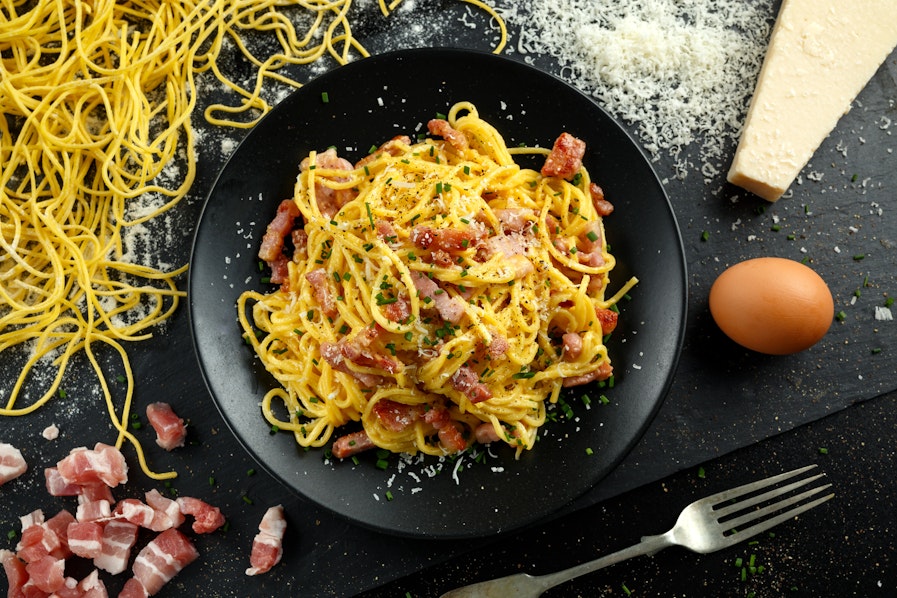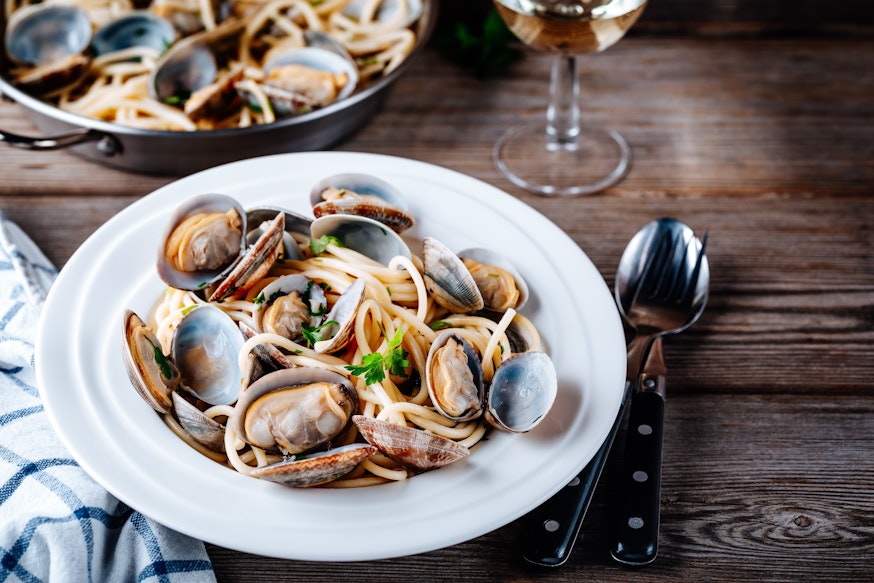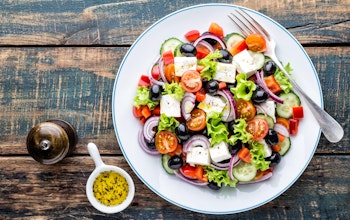World’s most famous pasta dishes

Filling, versatile and delicious - pasta runs the culinary gauntlet all the way from gourmet to nursery food and can combine with a plethora of other ingredients to create some of the world’s favourite dishes.
We’re rounding up the very best, certain to impress on your menu or at a dinner party - with some top tips to make your meal stand out and allergen information to boot.
The most famous pasta dishes are:
- Spaghetti Bolognaise
- Lasagne
- Fettuccine Alfredo
- Pasta Carbonara
- Ravioli
- Pasta alla Norma
- Spaghetti alle Vongole
- Macaroni Cheese
Now let’s find out more about them...
What is pasta?
Pasta is a food made from wheat flour and water, mixed into an unleavened door and boiled (or sometimes baked). For fresh pasta eggs are also added to the dough.
Pasta is a carbohydrate, with some fibre and protein, and whilst thought of as an Italian food (Italy is where most pasta recipes originate) it is likely descended from Asian noodles brought to Europe from China in the 13th century.
Pasta comes in a variety of shapes and sizes, with some popular varieties being:
- Spaghetti
- Tagliatelle
- Fettuccine
- Penne
- Farfalle
- Macaroni
- Orzi
- Rigatoni
- Fusilli
- Ziti
- Orecchiette
- Rotini
Spaghetti Bolognese

What is Spaghetti Bolognese?
Spaghetti bolognaise is a pasta dish consisting of spaghetti (long, thin cylindrical pasta) and a sauce made of minced beef, tomatoes, onion, bacon, red wine and herbs. It is commonly served with parmesan cheese. The dish is one of Italy’s most popular exports, and thought to have originated in Imola, a northern Italian city west of Bologna some time around the late 1800s - when the first reference to the dish’s ragu sauce was recorded.
Top tip
There are several ways you can ensure your bolognese is bursting with flavour. A small amount of sugar and lemon juice added to your tomatoes before cooking will make them pop, and a splash of worcestershire sauce to your ragu will add depth and body.
Allergen alert
Pasta is made with wheat flour, a Cereal containing Gluten - one of the 14 major food allergens. Fresh pasta is also made with Egg, another major allergen.
Most spaghetti bolognese recipes include red wine, which might contain Sulphites (one of the 14 major food allergens), and some also include Celery.
Though not in the actual recipe, this dish is often served with parmesan cheese, which is made from Milk (Milk is another of the 14 major food allergens).
Ragu recipes start with chopped onions - though not one of the 14 major food allergens, onions are an increasingly common upcoming allergen.
Lasagne

What is Lasagne?
Lasagne is a type of pasta that comes in flat, wide sheets but when people refer to lasagne they usually mean the dish - which layers the pasta with various fillings.
The most common lasagne layers are ragu (beef and tomato with seasonings) and bechamel sauce with a topping of parmesan cheese, but some recipes include vegetables, mushrooms or other kinds of meat and cheeses such as ricotta and mozzarella.
Lasagne is cooked in a square or rectangular casserole dish and cut into slices to serve.
Lasagne comes from the Italian city of Naples, though the first references to what we now think of as the dish came in a 14th century English cookbook.
Top tip
Want beautiful lasagne slices? Partially cook your lasagne and then allow to cool before cooking to serve, this will make the lasagne hold its shapes and stop the layers bleeding into each other and turning to mush.
Allergen alert
Lasagne is full of major food allergens. Pasta is made with wheat flour, a Cereal containing Gluten - one of the 14 major food allergens and fresh pasta is also made with Egg, another major allergen.
Lasagne recipes will also typically include red wine (Sulphites) in the ragu, and Milk and flour (Cereals containing Gluten) in the bechamel, with a cheese (also Milk) topping. Some recipes also include Celery.
Is pasta an allergen?
Yes, the main ingredient in pasta is wheat flour, a Cereal containing Gluten - one of the 14 major food allergens. Fresh pasta also contains Egg, another major allergen.
Fettuccine Alfredo

What is Fettuccine Alfredo?
Also known as fettuccine al burro (fettuccine with butter), fettuccine alfredo is a simple pasta dish consisting of fettuccine (flat pasta ribbons) tossed with parmesan cheese and butter. The process emulsifies the ingredients for a rich, silky finish.
The Alfredo part of the name refers to Alfredo di Lelio, who made great ceremony of having the dish prepared table-side at his Rome restaurant in the mid 20th century.
Many American recipes for Fettuccine Alfredo add cream and other ingredients - most Italians see this as a bastardisation of fettuccine al burro, a rustic national favourite and these additions should never be included in credible versions of the dish.
Top tip
Add a ladle of the water the pasta was cooked in (which should be ‘saltier than the Mediterranean') to the butter and parmesan when tossing with pasta. The water will act like glue between the pasta and sauce so the dish is fully combined.
Allergen alert
Pasta is made with wheat flour, a Cereal containing Gluten - one of the 14 major food allergens and fresh pasta is also made with Egg, another major allergen.
Fettuccine Alfredo’s other two main ingredients, butter and parmesan, are both Milk based. Milk is one of the 14 major food allergens.
Pasta Carbonara

What is Pasta Carbonara?
Pasta Carbonara is a dish combining a pasta variety such as penne or spaghetti with a cream-based sauce with ham or pancetta. The traditional Roman carbonara sauce contains eggs, a hard cheese such as pecorino or parmesan, cured pork, and black pepper and can be traced to the region of Lazio.
Top tip
Make sure your eggs are room temperature before cooking with them - if your eggs are too cold it can lead to lumps in your sauce and the only lumps should be cured pork.
Allergen alert
Pasta is made with wheat flour, a Cereal containing Gluten - one of the 14 major food allergens and fresh pasta is also made with Egg, another major allergen.
Milk and Eggs are main ingredients in a carbonara sauce and both are major allergens.
Is pasta suitable for those with Coeliac disease?
No, pasta is not suitable for those with Coeliac disease as it contains wheat, a Cereal containing Gluten. Gluten attacks the gut of those with Coeliac Disease and foods containing it are unsuitable for them to eat. However, there are many gluten-free pastas available to buy.
Ravioli

What is Ravioli?
Ravioli is a type of filled pasta. Often compared to little envelopes, ravioli fillings vary but popularly include ricotta cheese and spinach, seasoned with nutmeg, black pepper, spices and sometimes lemon rind (exact recipes differ from region to region).
Ravioli is referred to in literature from both Prato and Venice circa the 1500s, and usually served cooked in a broth or sauce.
Top tip
Ravioli filling should be ‘over’ seasoned. Because it is completely surrounded by pasta, the seasoning flavour can be lost unless there is enough of it. If you don’t add enough it won’t taste seasoned at all.
Allergen alert
Pasta is made with wheat flour, a Cereal containing Gluten - one of the 14 major food allergens and fresh pasta is also made with Egg, another major allergen.
The other allergens in ravioli depend on the filling and recipe, but ricotta cheese is made from Milk, a major allergen.
Is pasta vegan?
Some pasta is vegan and some pasta is not. Dried pasta is usually vegan, because the only ingredient is durum wheat, but fresh pasta is also made with egg - which is not vegan.
Pasta alla Norma

What is Pasta alla Norma?
Once known as pasta con le melanzane (pasta with aubergine), Pasta alla Norma got its name from an Italian composer called Vincenzo Bellini who wrote an opera called ‘Norma’. Bellini was from the Sicilian city of Catania, where the dish originates.
The dish consists of a pasta variety such as ziti or rigatoni cooked with aubergine, tomatoes, herbs, spices, capers and cheese.
Top tip
Whilst most pasta alla Norma recipes call for aubergine to be fried, roasting it is not only cleaner and easier, but it means the dish will be lighter and less greasy (aubergine is very absorbent).
Allergen alert
Pasta is made with wheat flour, a Cereal containing Gluten - one of the 14 major food allergens and fresh pasta is also made with Egg, another major allergen.
Pasta alla Norma may also include cheese (Milk), red wine or red wine vinegar (Sulphites) and anchovies (Fish) - all of which are major allergens.
Is pasta good for you?
Pasta is good for you so long as you don’t eat too much of it. It is rich in carbohydrates and protein, as well as folic acid and fibre. It is low in sodium and cholesterol-free, and does not cause blood-sugar spikes like other refined carbs do.
Wholemeal pasta is healthier as it contains twice as much fibre as white pasta. Tomato-based sauces contain fewer calories than cream-based sauces, which is worth bearing in mind when selecting a pasta dish.
Spaghetti alle Vongole

What is Spaghetti alle Vongole?
Spaghetti alle vongole translates into English as spaghetti with clams. It is part of traditional Neapolitan cuisine but eaten throughout Italy, and first appears as a recipe in Ippolito Cavalcanti, Duke of Buonvicino’s 1839 cookbook Cucina Teorico-pratica.
The dish can be cooked ‘in bianco’ - with garlic, oil, herbs and white wine, or ‘in rosso’ - with garlic, oil, herbs and tomatoes. Many different clam varieties can be used for this dish - palourde (carpet-shell), tellina (bean clam), or even cherrystone clams.
The clams open up as they are cooked in hot oil, adding flavour, before the pasta and other ingredients are added.
Top tip
Though not a traditional ingredient in this dish, butter can be added to the sauce to thicken and emulsify, for a richer and more decadent flavour.
Allergen alert
Pasta is made with wheat flour, a Cereal containing Gluten - one of the 14 major food allergens and fresh pasta is also made with Egg, another major allergen.
Clams are a Mollusc, one of the 14 major food allergens, and if white wine is used in the recipe there may be traces of Sulphites too.
Macaroni Cheese

What is Macaroni Cheese?
Macaroni cheese is a pasta dish commonly associated with American cuisine, and although legend has it that former president Thomas Jefferson brought the recipe back to his native US from Paris, it’s first official recording is in Elizabeth Raffald's 1769 book, The Experienced English Housekeeper.
The dish consists of macaroni (short, tubular) pasta, baked in a cheesy bechamel sauce (also known as a Mornay sauce) in the oven. Cheddar is the most popular cheese used, and some variations also add ingredients such as breadcrumbs, cherry tomatoes or pancetta. In the US it is often sold in packets and cooked on the stove with milk.
Top tip
Cubed potatoes can add texture to your macaroni cheese, and absorb the sauce beautifully. Use waxy potatoes cut into 2cm squares and bring to the boil in salted water, allowing to bubble away for five minutes before adding the pasta to the water to cook.
Allergen alert
Pasta is made with wheat flour, a Cereal containing Gluten - one of the 14 major food allergens and fresh pasta is also made with Egg, another major allergen.
Cheese is made from Milk, another of the major allergens, and depending on the recipe macaroni cheese may also include Celery, Milk and white wine (Sulphites).








